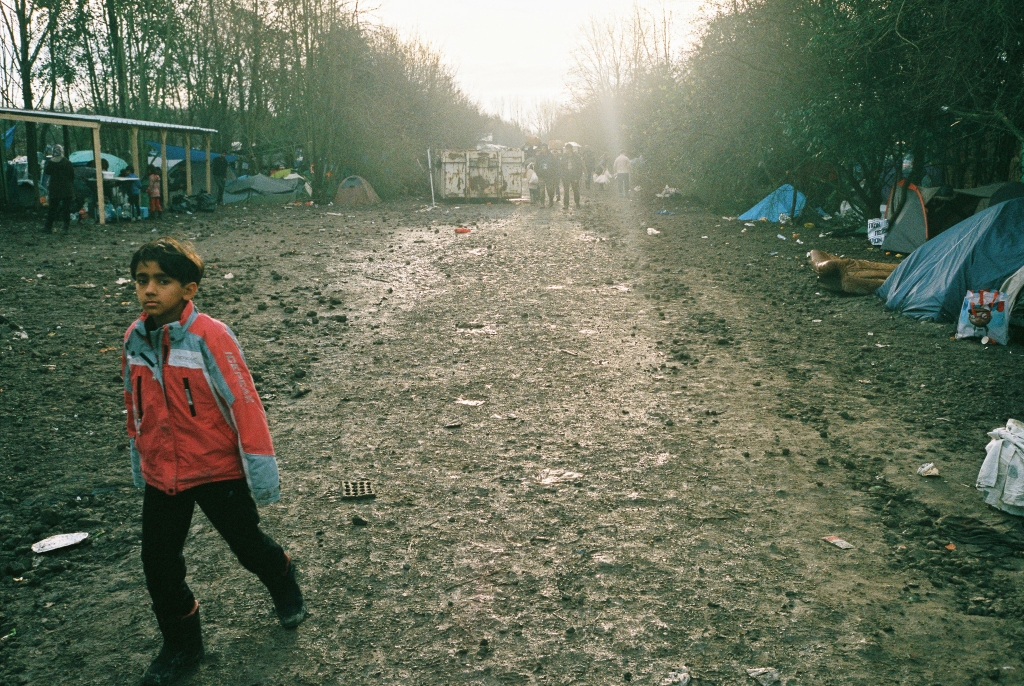
Grande-Synthe is being dubbed ‘The forgotten camp’ – I wasn’t prepared for what I saw there, not even remotely prepared….
The camp wasn’t where I’d expected it to be – we drove around the Dunkirk port area and scoured the outskirts of town before finally admitting defeat. We stopped for fuel, so while I was filling the van my assistant went into the petrol station to pay, seizing the opportunity to ask for directions. This smaller camp – home to about 2, 500 people – is situated in a wooded area between a football stadium and a housing estate… we must have driven past it a dozen times during our search.
There’s one entrance into the camp, through a gate opposite a row of bungalows. The gate is guarded by police… anyone going in carrying anything larger than a small bag is searched, which was unexpected. I later discovered that local authorities have passed a bye-law which prevents anyone from taking anything into the camp apart from clothing and food: so no tents, firewood, building supplies or sleeping bags. Some might say this is to stop the camp growing, others would see it as attrition. What used to be a grassy field is now a sea of deep mud, rubbish and human faeces… the only vaguely solid ground is the 600 metre long track that runs through the middle of the camp. Unlike the Jungle, Grande-Synthe lacks any of the hustle and bustle, the community spirit, of the larger camp. I’d been in France for a week and I’d seen some pretty harrowing things whilst in Calais… but on this day, for the first time, I got a bit upset. I’m not sure if it was a culmination of various things, or one particular sight… possibly the toddler wandering around in mud soaked pyjamas? There are over 150 young children at Grande-Synthe.
I didn’t take many photographs in Grande-Synthe – just one roll each of 35mm and 120. The 35mm very nearly didn’t make it out. As I approached the gate to exit the camp, a policeman stopped me and told me to delete the photograph I’d taken of him. My assistant, Calum, translated for me, explaining that I wasn’t aware I’d photographed him and that I couldn’t delete the image anyway because it was taken on film. It took a fair amount of apologising, through Calum, to not have to rip the film out of the camera. The Compagnies Républicaines de Sécurité had the last word, in English: “You do not photograph. It is the law.”
Since returning home, I’ve read that the French authorities in Dunkirk are spending €1.1 million to move the camp to a different location. It’ll be interesting to see how that transition pans-out…
The forgotten camp? I don’t think Grande-Synthe has been forgotten, you can’t forget something if you never knew it existed in the first place.
Images made using a Pentax 67, Olympus MjuII and Kodak Portra 400 film. Developed and scanned at UK Film Lab








Stunning, heartbreaking photojournalism. You should be proud of yourself, Phil.
LikeLiked by 1 person
Proud of my wolf xxx
LikeLiked by 2 people
Raw, honest and harrowing – I’ll join the list of people who are extremely proud of you 🙂
LikeLike
Thank you Phil!
LikeLiked by 1 person
Heartbreaking.
Are they hoping asylum seekers will go away by not allowing them tents & bedding etc? This is totally disgusting.
How on earth are they surviving in the harsh conditions?
LikeLike
I’ve sat here for five minutes trying to come up with something to say. All I can come up with is cursing.
LikeLiked by 1 person
Makes you thankful for what you have in life. Will it ever end, considering the continuing conflicts around the world?
LikeLiked by 1 person
As you said, you can’t forget something that isn’t known. Great work and fearless photojournalism.
LikeLike
Disturbing!
Have you sent any of this material to the press? I think you should.
LikeLiked by 1 person
Truly eye opening photography. One would expect this in the developing world like Africa or the Middle East, not France. Scary and completely unnerving.
LikeLike
It’s horrendous to think of people living in these conditions. Where do human rights fit in here, they clearly don’t. You have done well Phil, bringing back some beautiful but harrowing pictures which is a good thing for the world to see.
LikeLiked by 1 person
What a mess . . . great shots and great work.
LikeLiked by 1 person